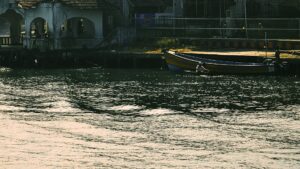 As sea levels rise and extreme weather intensifies, a silent but destructive force is infiltrating coastlines across the globe: salt. A new international study reveals how creeping salinisation caused by the inland movement of seawater is posing an escalating threat to freshwater supplies, agriculture, and communities in low-lying coastal areas, starting with the Bengal Delta in Bangladesh.
As sea levels rise and extreme weather intensifies, a silent but destructive force is infiltrating coastlines across the globe: salt. A new international study reveals how creeping salinisation caused by the inland movement of seawater is posing an escalating threat to freshwater supplies, agriculture, and communities in low-lying coastal areas, starting with the Bengal Delta in Bangladesh.
The study, published in Ecological Indicators, offers one of the most detailed long-term analyses of salinity trends in any delta system worldwide. Led by scientists from the University of Portsmouth, in collaboration with Dhaka University and Curtin University, the research tracked salinity levels in coastal rivers and estuaries using nearly two decades of data from over 50 monitoring stations across Bangladesh.
The findings are stark. Salt levels in the region’s water systems have been steadily climbing since the mid-2000s, especially in western parts of the delta. This trend has accelerated following powerful cyclones like Sidr in 2007, which pushed seawater further inland and disrupted the natural balance between fresh and saltwater. The combination of rising seas, decreasing upstream freshwater flows, and storm surges is intensifying saltwater intrusion deep into rivers and underground aquifers.
The environmental consequences are already being felt. Salinisation is turning fertile farmland barren, threatening food security for millions and pushing some rural communities to relocate. It is also contaminating drinking water sources, posing a growing risk to public health.
The researchers introduced a new model the Offshore Controlled Estuarine and Aquifer Nexus (OCEAN) framework which highlights how offshore seabed features and tidal restrictions can worsen salinity buildup. Their analysis shows that land-based efforts to fight saltwater intrusion, such as dams and embankments, often backfire by blocking the very freshwater flows that help flush out salt. At the same time, ocean dynamics like sediment deposits and shifting currents play a much larger role than previously understood.
This study doesn’t just sound the alarm for Bangladesh. It underscores a global pattern that’s emerging in other vulnerable regions like the Mekong Delta in Vietnam, Louisiana’s wetlands in the U.S., and parts of coastal California. As seas rise and storms strengthen, these places too face the threat of turning salty making once-productive land infertile and water supplies undrinkable.
Some regions, like Los Angeles County, are experimenting with injecting freshwater into aquifers to block seawater. But growing urban demand and ongoing groundwater extraction are straining these defenses. The challenge is bigger than any one solution.
The researchers stress the need for global, integrated approaches that connect river management, ocean science, and climate adaptation. Short-term data is no longer enough long-term, high-resolution monitoring is essential to fully understand and respond to this creeping crisis.
The Bengal Delta, home to over 160 million people, is on the frontlines of this shift. But as the study shows, its struggle is a preview of what lies ahead for coastal regions worldwide. Without urgent investment in salt-resilient farming, sustainable water storage, and cross-border planning, salinisation could become one of the defining disruptions of the climate era.
